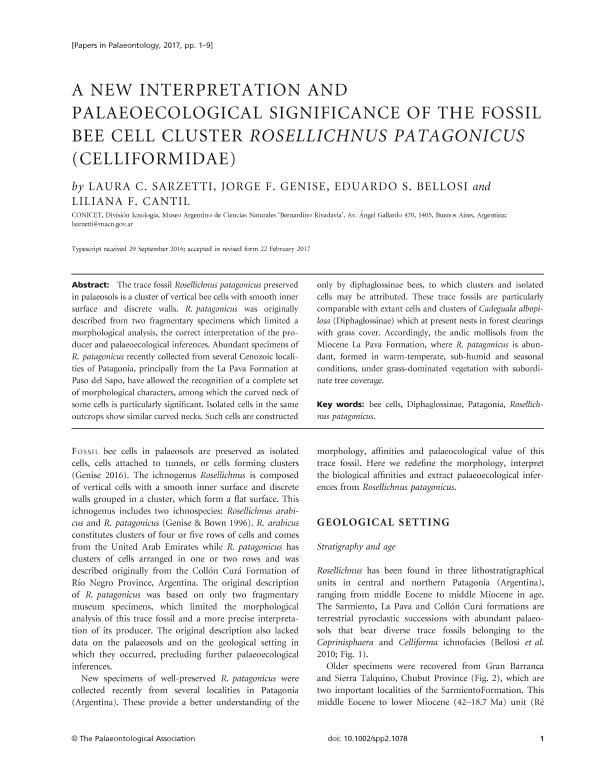Artículo
A new interpretation and palaeoecological significance of the fossil bee cell cluster Rosellichnus patagonicus (Celliformidae)
Sarzetti, Laura Cristina ; Genise, Jorge Fernando
; Genise, Jorge Fernando ; Bellosi, Eduardo Sergio
; Bellosi, Eduardo Sergio ; Cantil, Liliana Fernanda
; Cantil, Liliana Fernanda
 ; Genise, Jorge Fernando
; Genise, Jorge Fernando ; Bellosi, Eduardo Sergio
; Bellosi, Eduardo Sergio ; Cantil, Liliana Fernanda
; Cantil, Liliana Fernanda
Fecha de publicación:
08/2017
Editorial:
Wiley Blackwell Publishing, Inc
Revista:
Papers in Palaeontology
ISSN:
2056-2802
Idioma:
Inglés
Tipo de recurso:
Artículo publicado
Clasificación temática:
Resumen
The trace fossil Rosellichnus patagonicus preserved in palaeosols is a cluster of vertical bee cells with smooth inner surface and discrete walls. R. patagonicus was originally described from two fragmentary specimens which limited a morphological analysis, the correct interpretation of the producer and palaeoecological inferences. Abundant specimens of R. patagonicus recently collected from several Cenozoic localities of Patagonia, principally from the La Pava Formation at Paso del Sapo, have allowed the recognition of a complete set of morphological characters, among which the curved neck of some cells is particularly significant. Isolated cells in the same outcrops show similar curved necks. Such cells are constructed only by diphaglossinae bees, to which clusters and isolated cells may be attributed. These trace fossils are particularly comparable with extant cells and clusters of Cadeguala albopilosa (Diphaglossinae) which at present nests in forest clearings with grass cover. Accordingly, the andic mollisols from the Miocene La Pava Formation, where R. patagonicus is abundant, formed in warm‐temperate, sub‐humid and seasonal conditions, under grass‐dominated vegetation with subordinate tree coverage.
Palabras clave:
Bee Cells
,
Diphaglossinae
,
Patagonia
,
Rosellichnus Patagonicus
Archivos asociados
Licencia
Identificadores
Colecciones
Articulos(MACNBR)
Articulos de MUSEO ARG.DE CS.NAT "BERNARDINO RIVADAVIA"
Articulos de MUSEO ARG.DE CS.NAT "BERNARDINO RIVADAVIA"
Citación
Sarzetti, Laura Cristina; Genise, Jorge Fernando; Bellosi, Eduardo Sergio; Cantil, Liliana Fernanda; A new interpretation and palaeoecological significance of the fossil bee cell cluster Rosellichnus patagonicus (Celliformidae); Wiley Blackwell Publishing, Inc; Papers in Palaeontology; 3; 3; 8-2017; 363-371
Compartir
Altmétricas



